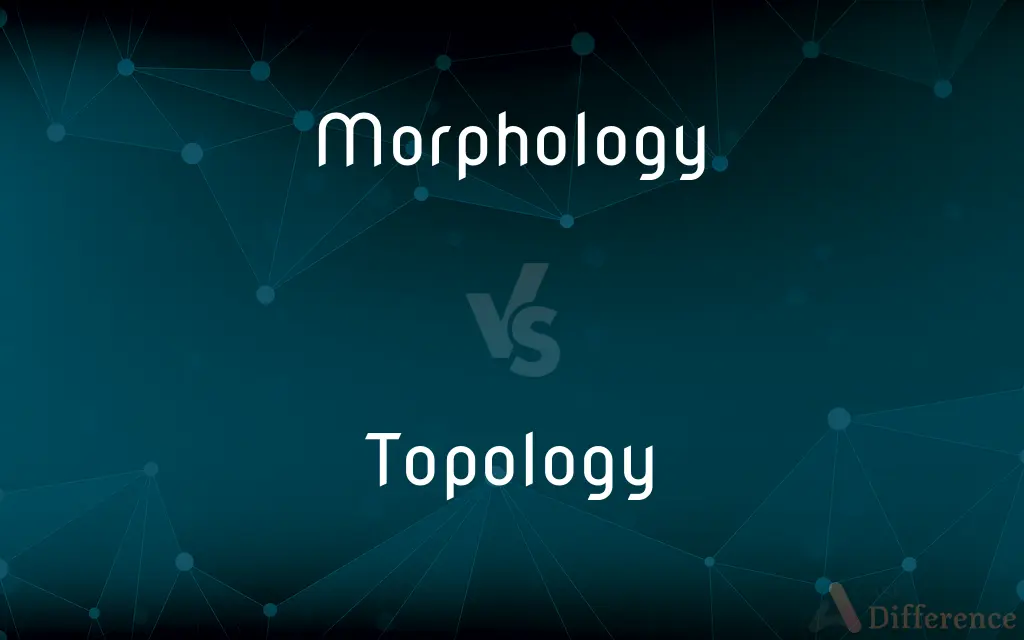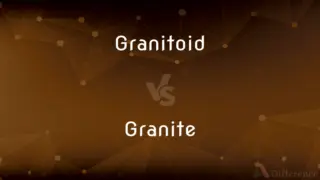Morphology vs. Topology — What's the Difference?
By Tayyaba Rehman — Updated on October 26, 2023
Morphology refers to the study of forms and structure of organisms or things, while Topology examines properties of space that are preserved under continuous deformations.

Difference Between Morphology and Topology
Table of Contents
ADVERTISEMENT
Key Differences
Morphology and Topology, though both scientific terms, relate to different domains of study. Morphology is chiefly concerned with the study of the form and structure of things, most commonly organisms or parts of organisms. It delves into the intricate patterns, structures, and design of entities. Topology, on the other hand, is a branch of mathematics that deals with properties of space preserved under continuous deformations like stretching or twisting but not tearing or gluing.
In biological contexts, Morphology is utilized to understand the external and internal physical characteristics of organisms, shedding light on evolutionary patterns or functional attributes. Topology, in its mathematical sphere, doesn't concern itself with metrics like distance but is more interested in the inherent properties of spaces and the transformations they can undergo without fundamentally altering their nature.
For linguists, Morphology is a term describing the study of the structure and formation of words. It examines how words are built from smaller units, called morphemes. Topology, in this context, doesn't have a direct linguistic application but remains rooted in its mathematical definition, dealing with the study of spatial properties.
It's fascinating how the scope of these terms varies depending on the context. Morphology can describe the shape of a river in geography or the structure of a word in linguistics, while Topology remains primarily a mathematical concept, pivotal in understanding the very fabric of the universe, as seen in theoretical physics.
Comparison Chart
Primary Domain
Biology, Linguistics
Mathematics
ADVERTISEMENT
Focus
Form and structure of organisms or things
Properties of space under continuous deformations
Application
Describes physical characteristics or word formation
Deals with spatial properties without regard to distance
Examples
Shape of leaves, structure of words
Doughnut and coffee cup being topologically equivalent
Contextual Variation
Can vary from biology to linguistics
Primarily a mathematical concept
Compare with Definitions
Morphology
Branch of biology detailing organismal structures.
Evolutionary morphology examines structural changes over time.
Topology
Branch of mathematics focusing on spatial properties.
Topology explores concepts beyond traditional geometry.
Morphology
Investigation into patterns and designs of entities.
The morphology of crystals is affected by external conditions.
Topology
Examination of properties preserved without tearing or gluing.
Topology allows for understanding of stretchable and compressible spaces.
Morphology
Study of forms and structures in organisms.
The biologist specialized in plant morphology.
Topology
Investigates transformations not altering spatial essence.
Theoretical physics often employs topology to understand the universe's fabric.
Morphology
Analysis of word structures in linguistics.
Morphology helps us understand word formation in languages.
Topology
In mathematics, topology (from the Greek words τόπος, 'place, location', and λόγος, 'study') is concerned with the properties of a geometric object that are preserved under continuous deformations, such as stretching, twisting, crumpling, and bending; that is, without closing holes, opening holes, tearing, gluing, or passing through itself. A topological space is a set endowed with a structure, called a topology, which allows defining continuous deformation of subspaces, and, more generally, all kinds of continuity.
Morphology
Descriptive study of any form or structure.
River morphology can indicate past geological events.
Topology
The study of geometrical properties and spatial relations unaffected by the continuous change of shape or size of figures.
Morphology
The study of the forms of things.
Topology
The way in which constituent parts are interrelated or arranged
The topology of a computer network
Morphology
A particular form, shape, or structure.
Topology
Topographic study of a given place, especially the history of a region as indicated by its topography.
Morphology
The branch of biology that deals with the form and structure of organisms without consideration of function.
Topology
(Medicine) The anatomical structure of a specific area or part of the body.
Morphology
The form and structure of an organism or one of its parts
The morphology of a cell.
The morphology of vertebrates.
Topology
The study of certain properties that do not change as geometric figures or spaces undergo continuous deformation. These properties include openness, nearness, connectedness, and continuity.
Morphology
(Linguistics) The study of the structure and form of words in language or a language, including inflection, derivation, and the formation of compounds.
Topology
The underlying structure that gives rise to such properties for a given figure or space
The topology of a doughnut and a picture frame are equivalent.
Morphology
(uncountable) A scientific study of form and structure, usually without regard to function. Especially:
Topology
(Computers) The arrangement in which the nodes of a network are connected to each other.
Morphology
(linguistics) The study of the internal structure of morphemes (words and their semantic building blocks).
Topology
The branch of mathematics dealing with those properties of a geometrical object (of arbitrary dimensionality) that are unchanged by continuous deformations (such as stretching, bending, etc., without tearing or gluing).
Morphology
(biology) The study of the form and structure of animals and plants.
Topology
(topology) Any collection τ of subsets of a given set X that contains both the empty set and X, and which is closed under finitary intersections and arbitrary unions.
A set equipped with a topology is called a topological space and denoted .
The subsets of a set which constitute a topology are called the open sets of .
Morphology
(geology) The study of the structure of rocks and landforms.
Topology
(medicine) The anatomical structure of part of the body.
Morphology
(math) Mathematical morphology.
Topology
(computing) The arrangement of nodes in a communications network.
Morphology
(countable) The form and structure of something.
Topology
(technology) The properties of a particular technological embodiment that are not affected by differences in the physical layout or form of its application.
Morphology
(countable) A description of the form and structure of something.
Topology
(topography) The topographical study of geographic locations or given places in relation to their history.
Morphology
That branch of biology which deals with the structure of animals and plants, treating of the forms of organs and describing their varieties, homologies, and metamorphoses. See Tectology, and Promorphology.
Topology
(dated) The art of, or method for, assisting the memory by associating the thing or subject to be remembered with some place.
Morphology
The form and structure of an organism.
Topology
The art of, or method for, assisting the memory by associating the thing or subject to be remembered with some place.
Morphology
The branch of linguistics which studies the patterns by which words are formed from other words, including inflection, compounding, and derivation.
Topology
A branch of mathematics which studies the properties of geometrical forms which retain their identity under certain transformations, such as stretching or twisting, which are homeomorphic. See also topologist.
Morphology
The study of the patterns of inflection of words or word classes in any given language; the study of the patterns in which morphemes combine to form words, and the rules for combination; morphemics; as, the morphology of Spanish verbs; also, the inflection patterns themselves.
Topology
Configuration, especially in three dimensions; - used, e. g. of the configurations taken by macromolecules, such as superhelical DNA.
Morphology
The branch of biology that deals with the structure of animals and plants
Topology
Topographic study of a given place (especially the history of place as indicated by its topography);
Greenland's topology has been shaped by the glaciers of the ice age
Morphology
Studies of the rules for forming admissible words
Topology
The study of anatomy based on regions or divisions of the body and emphasizing the relations between various structures (muscles and nerves and arteries etc.) in that region
Morphology
The admissible arrangement of sounds in words
Topology
The branch of pure mathematics that deals only with the properties of a figure X that hold for every figure into which X can be transformed with a one-to-one correspondence that is continuous in both directions
Morphology
The branch of geology that studies the characteristics and configuration and evolution of rocks and land forms
Topology
The configuration of a communication network
Topology
Study of properties of space under continuous deformations.
In topology, a circle can be transformed into an ellipse.
Topology
Deals with nature of connectedness in mathematics.
Network topology outlines how different nodes are connected.
Common Curiosities
How does Morphology apply in biology?
In biology, Morphology pertains to the external and internal physical characteristics of organisms.
Can Morphology relate to language?
Yes, in linguistics, Morphology describes the structure and formation of words.
How does Topology differ from Morphology?
While Morphology focuses on forms and structures, Topology examines properties of space preserved under continuous deformations.
Can Morphology describe geographical formations?
Yes, terms like "river morphology" describe the shapes and structures of geographical entities.
What is Morphology?
Morphology refers to the study of the form and structure of organisms or things.
Does Topology concern itself with distances?
No, Topology is more interested in inherent spatial properties and doesn't focus on metrics like distance.
What are some common themes in Topology?
Common themes include connectedness, continuity, and boundary definitions.
Is Topology strictly a mathematical concept?
Primarily, yes. Topology is a branch of mathematics dealing with spatial properties and continuous deformations.
Does Topology have any connection to theoretical physics?
Yes, theoretical physics often employs Topology to explore and understand the fabric of the universe.
Can Topology explain why a doughnut and coffee cup are similar?
Yes, in Topology, a doughnut and coffee cup are considered equivalent because they can be transformed into one another without tearing or gluing.
Can Morphology refer to non-biological structures?
Absolutely, Morphology can describe any form or structure, even those not pertaining to living organisms.
What are morphemes in the context of Morphology?
In linguistics, morphemes are the smallest units of meaning, and Morphology studies how they form words.
Are Morphology and Topology ever interrelated?
While they focus on different domains, interdisciplinary studies, especially in theoretical physics, might utilize concepts from both.
How does Morphology assist in evolutionary studies?
Evolutionary Morphology studies structural changes in organisms over time, aiding in understanding evolutionary patterns.
Is there a practical application for Topology?
Yes, apart from theoretical math and physics, it's used in computer networks to describe network layouts or "network topology".
Share Your Discovery

Previous Comparison
Cooler vs. Esky
Next Comparison
Granitoid vs. GraniteAuthor Spotlight
Written by
Tayyaba RehmanTayyaba Rehman is a distinguished writer, currently serving as a primary contributor to askdifference.com. As a researcher in semantics and etymology, Tayyaba's passion for the complexity of languages and their distinctions has found a perfect home on the platform. Tayyaba delves into the intricacies of language, distinguishing between commonly confused words and phrases, thereby providing clarity for readers worldwide.














































